Non⁃Negligible Influences of Rain on 5G Millimeter Wave Terrestrial Communication System
(1.School of Physics and Optoelectronic Engineering,Xidian University,Xi’an 710071,China;2.Algorithm Department,ZTE Corporation,Shanghai 200240,China)
Abstract: The impacts of rain on millimeter wave(mmW)terrestrial links,which are inev⁃itably affected by ground-objects-induced multipath propagation,are presented based on the signal time series data measured at 35 GHz.We analyze the coupled influence mecha⁃nism of rain-induced and ground-objects-induced multipath propagation on mmW terres⁃trial links.It can be deduced that the rain-induced impacts on millimeter wave terrestrial links cannot be neglected.The results given in this paper are significant for developing 5G millimeter wave terrestrial mobile communication links.
Keywords: 5G communication;mmW;multipath;rain-caused effects;terrestrial links
1 Introduction
Millimeter wave (mmW) technology is regarded as a key technology for 5G mobile communication sys⁃tem,because it is greatly helpful for solving the bot⁃tleneck problems,which are the main contradictions between the required traffic in the future and the current 2G,3G and 4G communication systems[1–5].Meanwhile,it is also necessary to face more complex propagation characteristics for fully taking advantage of millimeter wave technology[6–8].
One of the principal technical difficulties for mmW technol⁃ogy is to evaluate the impacts of the troposphere,such as raininduced attenuation,depolarization and noise.The propaga⁃tion characteristics of millimeter wave in the troposphere have been regarded as an important part of radio wave propagation field[9].Many calculating models and measured data about the propagation properties are given,and ITU-R models may be the most authoritative and reliable[10–11].In general,rain-in⁃duced impacts are the most severe impacts and the first aspect to consider.Therefore,rain-induced impacts are also present⁃ed in 5G plans.Some publications[12–15]think that the rain-in⁃duced impacts on the terrestrial cellular scale link with sever⁃al hundred meters of path length do not cause significant addi⁃tional influences and even can be ignored,which is concluded based on the calculating results using the ITU-R models.
However,5G mobile communication system will be applied to complex terrain and ground objects environment[7–8].Conse⁃quently,the multipath propagation caused by terrain or ground objects is inevitable.Recent studies have revealed that the multipath propagation is an important factor affecting the millimeter-wave propagation characteristics[9–10].Hence,with the increasing complexity of terrain and ground objects,the multipath effect is a key factor to affect the propagation char⁃acteristics of radio waves in 5G ground mobile link[16].
When it rains,multipath signals caused by terrain or ground objects will interact with raindrop particles,which may lead to more complex multipath signals[17–19].In other words,every path will be affected by raindrop-caused random absorp⁃tion and scattering,so the multipath signal is randomly chang⁃ing.As a result,received signals include the multipath signals caused by raindrops scattering and/or by terrain or ground ob⁃jects.A possible special case is that the raindrop absorption effect may also remove some terrain or ground objects-caused direct wave signals from the received signals,which means that those terrain or ground objects-caused signal arrival direc⁃tions are objectively exist but the signals from those directions just contain the multipath signals caused by raindrop scatter⁃ing.In a word,when a rain event occurs,the received signals in a complex terrain and ground object environment are likely to include two different kinds of multipath signals.According to the theory of vector superposition,the two different multipa⁃th signals will couple together and finally modulate channel ef⁃fects together.The two kinds of multipath signals may cause destructive or constructive interference and magnify the atmo⁃spheric transmission effects.Namely,the integrated impacts caused by rain are likely to be much more serious than the ef⁃fects forecasted by the ITU-R models,which are suitable for the propagation situation free from the effects of terrain and ground objects.Therefore,it may not be reliable to determine if the rain-induced effects can be ignored just according to the calculation results with the ITU-R models,and it is necessary to estimate the impacts of rain on mmW terrestrial links.
In this paper,the receiving signal time series at 35 GHz are measured in a selected multipath environment.The equivalent attenuation is obtained by comparing the received signals in rain with those measured in clear air.The measured data im⁃ply that,under a certain rain rate condition,the measured equivalent attenuation is much greater than the rain-induced attenuation calculated by the ITU-R P.530-12 model.The rea⁃sons for the enormous difference are analyzed by theoretical and experimental methods.According to the analysis results,it can be concluded that the transmission effects on mmW ter⁃restrial links,such as attenuation-induced fade,equivalent at⁃tenuation,phase-shift,and atmosphere noise,in rain environ⁃ment cannot be estimated by the classical models,which are built for computing the impacts induced solely by rain on mmW line of sight (LOS) links.In other words,it is necessary to adopt a completely new method for evaluating the transmis⁃sion effects on mmW terrestrial links in a rain environment,such as fading,depolarization,noise,and phase shift.The con⁃clusions given in this paper are significant for developing 5G mmW terrestrial links.
2 Equivalent Attenuation Measured in Se⁃lected Multipath Environment Under Rain Condition
Rain-induced attenuation should be the first consideration for designing mmW terrestrial links that work in a multipath environment.In order to study rain-induced attenuation char⁃acteristics of such the mmW links,we conducted a testing ex⁃periment using a terrestrial link at 35 GHz.The testing ex⁃periment system includes two parts:meteorological parame⁃ter measurement system and equivalent attenuation measure⁃ment system.As shown in Fig.1a,the meteorological param⁃eter measurement system is composed of an OTT Parsivel la⁃ser particle spectrometer and a computer.The equivalent at⁃tenuation measurement system includes a transmitter,a re⁃ceiver,a spectrum analyzer and a computer,which are shown in Fig.1b.The technical parameters of the OTT Parsivel la⁃ser particle spectrometer can be found in any official specifi⁃cation,which will not be introduced in this paper.The main parameters of the transmitter and the receiver are listed in Table 1.
In order to investigate the influence of rain on mmW terres⁃trial links,the testing system was located at the 5th floor of the West Building of Xidian University,where the random-groundobjects-induced multipath propagation can be neglected with very high approximation,but the static-ground-objects-in⁃duced multipath propagation was taken into consideration.Fig.2 shows the testing scenario,where the receiving and transmitting antennas are on the same side,namely,the receiv⁃ing antenna can receive the signals reflected from the ground and the opposite wall.It should be noted that the Fresnel main region cannot be used to estimate the occurrence or nonoccur⁃rence of multipath propagation,because it is only valid for the incidence case of a plane wave from a transmitting antenna to a receiving antenna.It is obvious that the propagation scenar⁃io in Fig.2 is not the plane wave incidence case.
Fig.3 shows our testing flow,where a spectrum analyzer is connected with the output port of the receiver’s downconvert⁃er,hence the spectrum analyzer monitors the power level of re⁃ceived signals and saves them into the computer by every min⁃ute; at the same time,the atmospheric parameters are record⁃ed.The rain-induced equivalent attenuation time sequence can be obtained by subtracting the power level time sequence in rain from the reference power level.Note that the reference power level is the average power level of the signals that are received within 20 minutes before every rain event occurs.
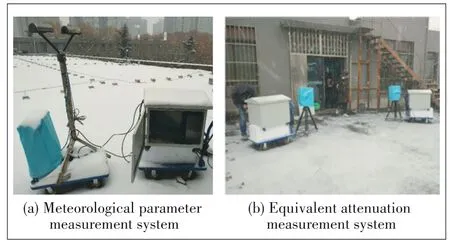
▲Figure 1.Testing experiment system of meteorological parameter measurement.
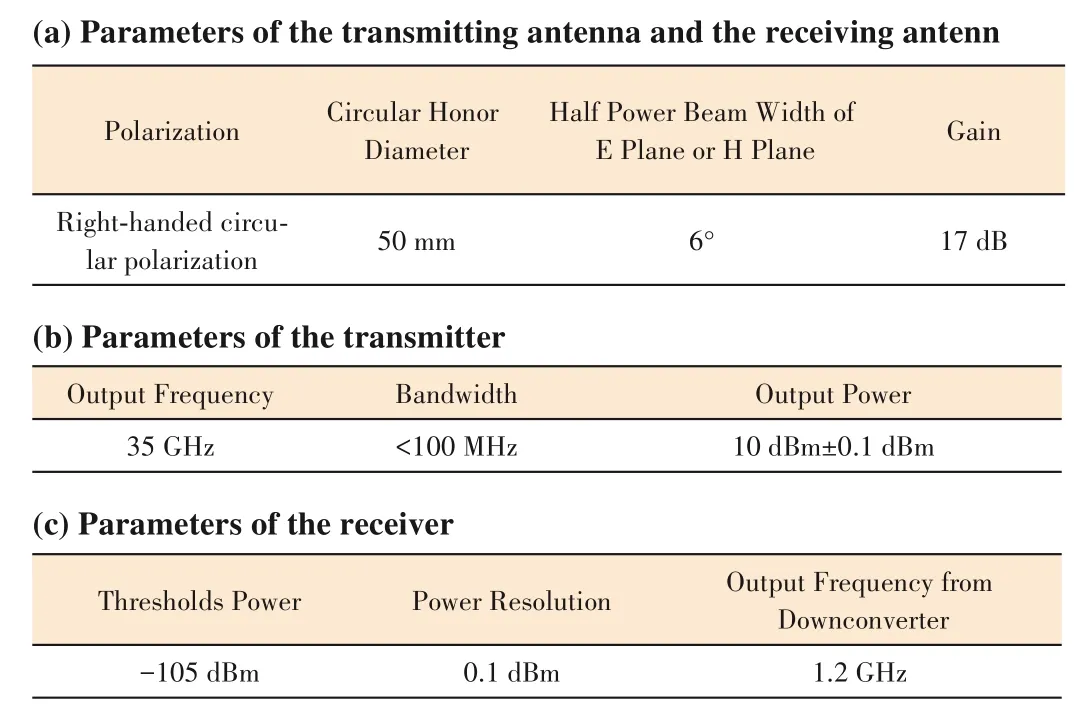
▼Table 1.Main parameters of the transmitter and the receiver
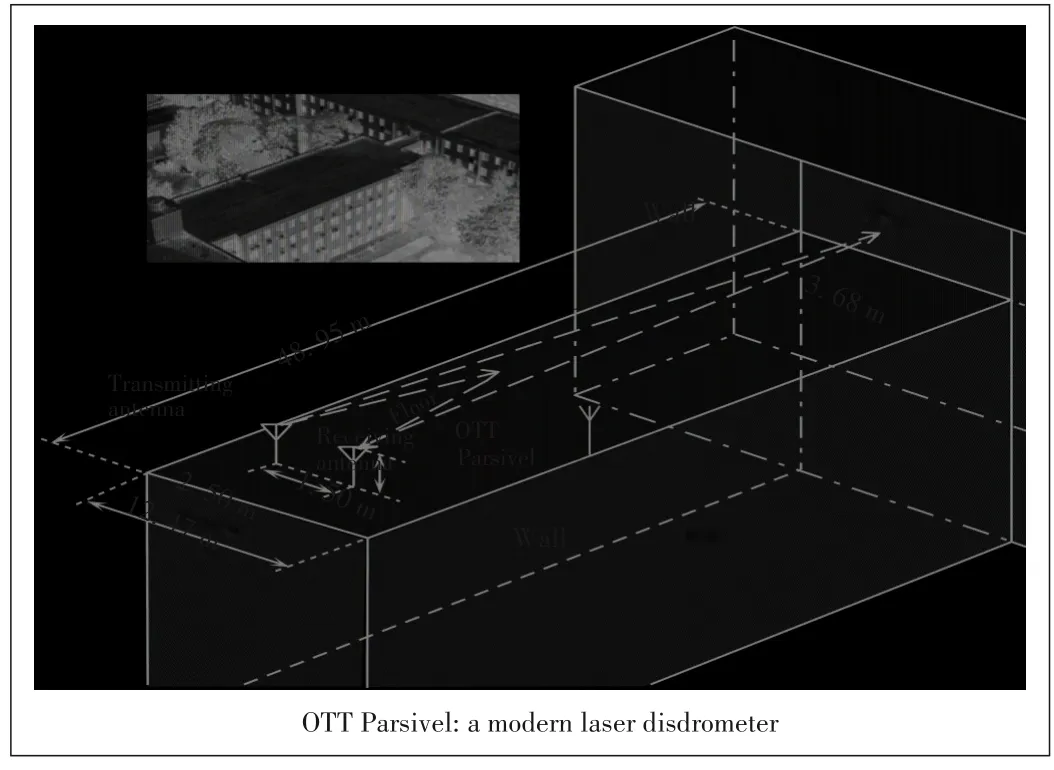
▲Figure 2.Testing scenario in static-ground-objects-induced multipath propagation environment.
During the measurement period from August 2017 to Janu⁃ary 2018,about 3 500 minute time sequence of one-minute in⁃tegration rain rate and the corresponding equivalent attenua⁃tion time series were recorded.In order to investigate the raininduced influence on mmW terrestrial links,the rain-induced attenuation of 100 m path for the measured rain rate data is calculated by


▲Figure 3.Testing flow chart of meteorological parameter measurement.
Rin Eq.(1) notes the one-minute integration rain rate,which is replaced by the measured rain rate given in Fig.4.ah,av,bhandbvin Eqs.(2) and (3) are taken asah=0.3374,av=0.3224,bh=0.9047 andbv=0.8761 at 35 GHz,which are given in ITU-R P.838-3.Eq.(1) implies that it is true that the rain rate along the 100 m path in Fig.2 is the same as that at the testing position.The measured equivalent attenuation and the calculated attenuation are shown in Fig.4.
It is obvious that the values of the measured equivalent at⁃tenuation testing are larger than those of the calculated attenu⁃ation.The difference may be caused by the fact that the raininduced attenuation is dependent not only on the rainfall type,raindrops’shape and size distribution,which determine the coefficients ofah,av,bhandbvin Eqs.(2) and (3),but also on the space distribution of the rain rate,which determines the equivalent path length.In other words,the difference may aris⁃es from wrong values ofah,av,bhandbvor the unseemly ap⁃proximation of taking the geometry path length 0.1 km as the equivalent path length in Eq.(1).In addition,the difference in Fig.4 may also be generated by wet antenna[20–23].In order to verify the guesses mentioned above,another measurement in non-multipath environment was carried out.Fig.5 shows the testing scenario,which is the north campus of Xidian Universi⁃ty.The transmitter and the receiver were placed on the top of two buildings with a distance of 820 m,respectively,and the height difference between the transmitter and the receiver was about 20 m.It was sure that there were no ground objects in the Fresnel region of the link in Fig.5,the radius of which was aboutIn addition,it was sure that there were no ground objects in the two antennas’common beam space.Therefore,it is logical to consider the link in Fig.5 as a LOS link.

▲Figure 4.The results of the equivalent attenuation testing in the sce⁃nario given in Figure 2.

▲Figure 5.Test scenario in line of sight(LOS)propagation environment.
During the measurement period from March 2018 to June 2018,about 12 000 min time sequence of one-minute integra⁃tion rain rate and the corresponding equivalent attenuation time series were recorded.The rain-induced attenuation was also calculated by Eq.(1).The measured attenuation and the calculated attenuation are shown in Fig.6.
Fig.6 shows that the measured attenuation and the calculat⁃ed attenuation are approximatively matched.The subtle differ⁃ence should be caused by the wet antenna mentioned in Refs.[20]–[23].The results in Fig.6 verify that the difference be⁃tween the measured data and the calculated data in Fig.4 is not mainly caused by the wrongah,av,bhandbvor the unseem⁃ly approximation of taking the geometry path length 0.1 km as the equivalent path length in Eq.(1).In other words,the obvi⁃ous difference in Fig.4 is likely to be caused by the coupled influence of rain-caused effects and ground-objects-induced multipath propagation,and it is not reasonable to regard raininduced attenuation and other impacts on mmW terrestrial links as negligible factors just according to the traditional models,which are used to estimate the effects caused individ⁃ually by rain.In what follows,the coupled influence mecha⁃nism of rain-caused effects and ground-objects-induced mul⁃tipath propagation on mmW terrestrial link will be qualitative⁃ly analyzed.
3 Coupled Influence Mechanism of Rain-Caused Effects and Ground-Objects-In⁃duced Multipath Propagation on MmW Terrestrial Links
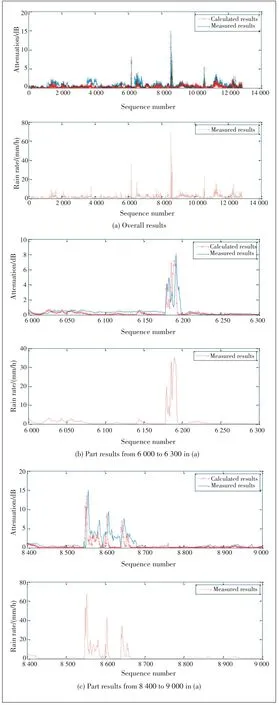
▲Figure 6.Results of attenuation testing in the scenario given in Figure 5.
In fact,the random variation of the power level received in the measured environment in Fig.5 is attenuation-induced fade,and the attenuation is caused individually by rain.Fur⁃thermore,Eq.(1) is just used to calculate the attenuation in⁃duced solely by rain.Consequently,the attenuation calculated by Eq.(1) is approximatively matched with that obtained by subtracting the power level time sequence in rain from the ref⁃erence power level,which is simply introduced in Section 2.However,each path of the multipath in Fig.2 is affected by rain-induced effects,such as attenuation and phase shift.That is,the fade of the power level received in the scenario in Fig.2 is induced by rain-caused multipath propagation.However,Eq.(1) is just used to calculate the attenuation induced only by rain.Therefore,the obvious difference in Fig.4 is inevita⁃ble and not surprising at all.
In order to qualitatively analyze the coupled influence mechanism of rain-caused effects and ground-objects-induced multipath propagation on mmW terrestrial links,the simplest two-path propagation case is considered (Fig.7).Suppose the vector complex amplitudes at the receiving antenna via Path-1 and Path-2 are E1and E2,respectively.The vector complex amplitude of the total field can be written as

The module|E|of E can be calculated by

whereθ2andθ1are the phase angles of E1and E2.The phase angleθof E can be calculated by

Moreover,the total power is proportional to |E|2,which is expressed as

For the similar scenario in Fig.2,in which the randomground-objects-induced multipath propagation can be ne⁃glected with very high approximation,if rain does not occur,|E1|,|E2| andθ1,θ2,are approximatively constant values.However,once rain occurs,|E1|,|E2|andθ1,θ2become ran⁃dom values because of rain-induced attenuation and scatter⁃ing.Based on the results in Ref.[24],|E1|,|E2| andθ1,θ2can be expressed as
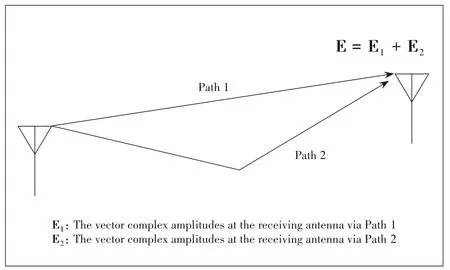
▲Figure 7.The two-path propagation case.


Based on Eq.(12),it is quite clear that(|E1|f)2,(|E2|f)2and the complex interference terms ofare introduced into|E|2.That is,the ground-objects⁃induced multipath propagation makes rain-induced scattering effect al⁃so more complicatedly impact the equivalent attenuation,be⁃cause the received power is proportional to|E|2.It can be con⁃cluded that|E|2will be more complex in more-path propaga⁃tion environment.Eq.(12) also implies that quantitatively in⁃vestigatingand|E1|f,|E2|f,θ1f,θ2fis necessary for quantitatively analyzing |E|2.However,and|E1|f,|E2|f,θ1f,θ2fare decided by not only rain-caused effects but also wet antennas and wet ground surface.The impact of wet antenna onandis reported in some publications[20–23].Moreover,it is very complicated to quantitatively analyze|E1|f,|E2|f,andθ1f,θ2fin rainy multipath environments.Therefore,Eq.(12) mathematically analyzes the coupled influence mech⁃anism of rain-caused effects and ground-objects-induced mul⁃tipath propagation on mmW terrestrial links,but the quantita⁃tive analysis of|E|2will not be given in this paper.In a word,the traditional model for calculating rain-induced attenuation is suitable for LOS propagation case,while the quantitative analysis of|E|2by the model similar to Eq.(12) is necessary for none LOS propagation case in rainy multipath environ⁃ments.Hence,the obvious difference in Fig.4 and the approx⁃imate accordance in Fig.6 are logical.
According to the same mechanism,it can be concluded that other rain-induced effects on mmW terrestrial links,such as depolarization,phase-shift and atmosphere noise,cannot be estimated by traditional models,which are used in LOS propa⁃gation case.Therefore,the impacts of rain on 5G mmW terres⁃trial links are likely to be non-negligible on account of the cou⁃pled impaction of rain-induced effects and multipath propaga⁃tion phenomenon,and it is necessary to deeply investigate the impacts of rain on 5G mmW terrestrial links.
4 Conclusions
The transmission effects,such as attenuation-induced fade,equivalent attenuation,phase-shift,and atmosphere noise,on mmW terrestrial links in rain environment are severer than those on mmW LOS links in rain because of the coupled ac⁃tion of rain-induced scattering and ground-objects–induced multipath propagation.For mmW terrestrial links,it is wrong to estimate rain-induced effects using traditional models,such as ITU-R models,which are suitable for LOS propagation cas⁃es.In other words,the impacts of rain on 5G mmW terrestrial communication system are likely to be non-negligible on ac⁃count of the coupled impaction of rain-induced effects and multipath propagation phenomenon.It is necessary to build a model for quantitatively estimating the transmission effects on mmW terrestrial links in rain environment,which has not been included in any previous publications,but the mathemat⁃ically analytic process in Section 3 is a good start and helpful to build such a model.The testing results in this paper are sig⁃nificant for developing 5G mmW terrestrial links.
- ZTE Communications的其它文章
- Leaky-Wave Antennas for 5G/B5G Mobile Communication Systems:A Survey
- Multibeam Antenna Based on Butler Matrix for 3G/LTE/5G/B5G Base Station Applications
- A Novel 28 GHz Phased Array Antenna for 5G Mobile Communications
- Design of Millimeter-Wave Antenna-in-Package(AiP)for 5G NR
- Integrated 3D Fan-out Package of RF Microsystem and Antenna for 5G Communications
- Electromagnetic Simulation with 3D FEM for Design Automation in 5G Era

